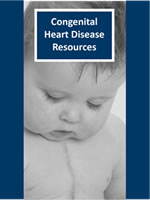Children and Youth with Special Health Needs (CYSHN)
Programs
Contact Info
Ventricular Septal Defect
Condition Description
A ventricular septal defect (VSD) is a congenital heart defect where the wall (septum) between the two lower pumping chambers of the heart (the ventricles) does not fully form, leaving a hole between the two chambers. Before birth, the heart starts out as a single tube that gradually differentiates into 4 chambers during development. Abnormalities can arise at several steps in the process, resulting in defects in the muscular walls that normally separate the heart's right and left ventricles.
With a VSD, the stronger left side of the heart pumps extra blood to the right ventricle through the hole, and that extra blood goes through the pulmonary artery to the lungs. In most cases the hole is in the membranous part of the septum; more serious VSDs are in the muscular part of the septum.
Babies with large VSDs will have excess fluid in their lungs, causing rapid and labored breathing and a fast heartbeat. They may have difficulty feeding because of tiring, and thus gain weight slowly. They can also be prone to respiratory infections. The flow of blood through the hole can cause a heart murmur, a sound of blood flow that can be heard through a stethoscope. A smaller VSD will typically have a louder murmur than a large VSD because the sound is made as the blood passes through the narrowed opening.
Ventricular septal defect is the most common of the congenital heart conditions, making up 25-30% of the congenital heart defects.
Most small VSDs will close by themselves, so babies will be closely observed for a few weeks or months to see if their symptoms improve. They may be treated with medications that strengthens the heart muscle and removes extra fluid from the body. Children will need to see a cardiologist periodically to be assessed for any signs of heart failure or other difficulties.
Individuals who have unrepaired VSDs will take antibiotics when they have dental work to prevent bacteria from the mouth from migrating through the blood system and causing an infection in the heart. For the first six months after VSD surgery antibiotics for dental work will be required; after that healing period, it will not be necessary for the child to take antibiotics for dental work.
Because VSD is the most common of heart defects, surgical repair is common and the outcomes are generally excellent. Children with repaired VSDs generally have a full recovery and no after-effects and normal growth and development.
- Using data from Minnesota births between 2016-2020, we found 2,248 babies were born with VSD’s, resulting in a rate of nearly 69 babies per 10,000 births. Annually, about 449 babies were born with ventricular septal defect.
